How to Best Perform Backflushing in SAP ERP
Executive Summary
- Backflushing, which can be described as postproduction issuing, is the method of issuing materials to production orders when the production of a specific operation is completed.
- Backflushing often works well when production runs are long and in repetitive manufacturing environments.
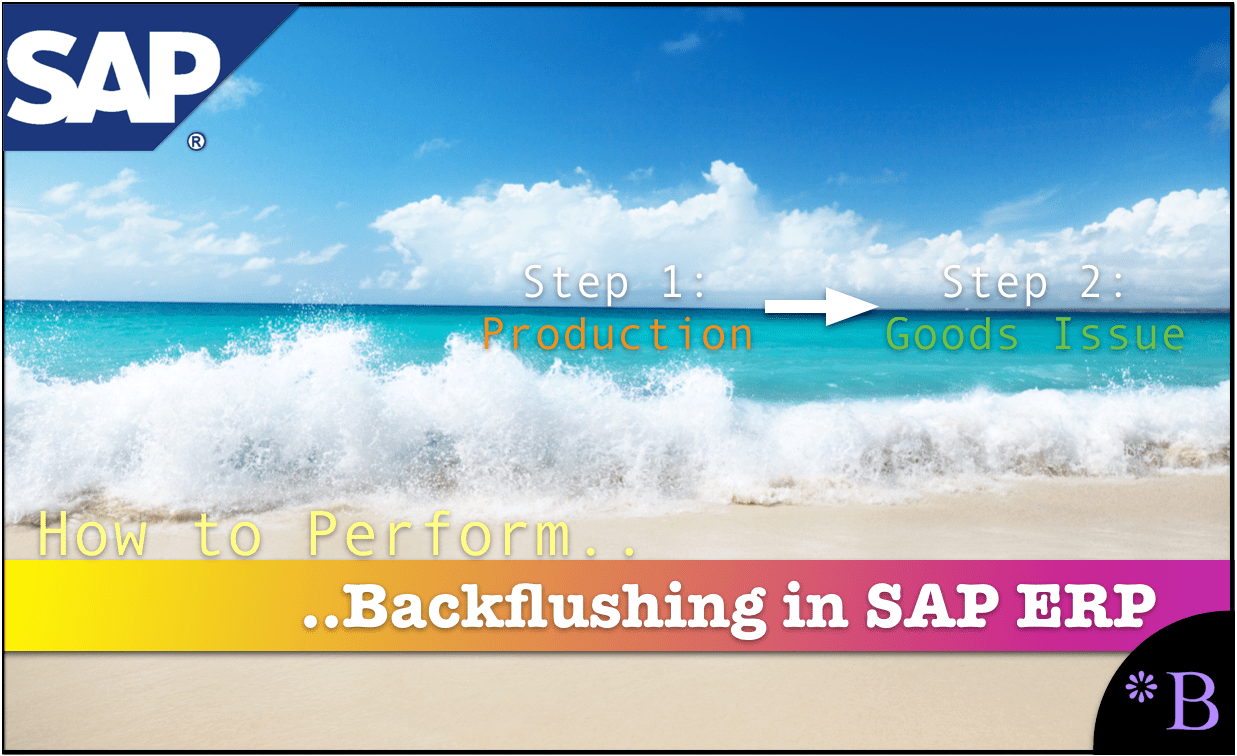
Video Introduction: How to Best Perform Backflushing in SAP ERP
Text Introduction (Skip if You Watched the Video)
Backflushing is a method of decoupling the goods issue process from the manufacturing process. This is configured in SAP ERP when specific conditions are met which are normally present in repetitive manufacturing. Setting up backflushing in SAP ERP keeps often large quantities of finished goods in a state where they have not been issued. You will learn the settings of backflushing in SAP ERP, and what the business requirements are for backflushing.
Our References for This Article
If you want to see our references for this article and other Brightwork related articles, see this link.
Notice of Lack of Financial Bias: We have no financial ties to SAP or any other entity mentioned in this article.
- This is published by a research entity, not some lowbrow entity that is part of the SAP ecosystem.
- Second, no one paid for this article to be written, and it is not pretending to inform you while being rigged to sell you software or consulting services. Unlike nearly every other article you will find from Google on this topic, it has had no input from any company's marketing or sales department. As you are reading this article, consider how rare this is. The vast majority of information on the Internet on SAP is provided by SAP, which is filled with false claims and sleazy consulting companies and SAP consultants who will tell any lie for personal benefit. Furthermore, SAP pays off all IT analysts -- who have the same concern for accuracy as SAP. Not one of these entities will disclose their pro-SAP financial bias to their readers.
What is Backflushing?
Backflushing is one of the most misleading terms.
Inventory ops have the following helpful definition for backflushing:
“Backflushing is simply an inappropriate and misleading term used to describe a method for issuing materials to production orders at the point that production of a specific operation is completed.“
I particularly like the way that Dave Piasecki essentially renames backflushing as postproduction issuing, which is a much more descriptive term, which of course, is the purpose of picking a term, to begin with. He then sets up the term “preproduction issuing“ as the usual way of issuing and the opposite of backflushing.
“To make things clearer, for a portion of this article I will refer to backflushing as postproduction issuing. I will also use the term preproduction issuing to describe the method(s) for issuing material most people are familiar with. It’s important to discuss the similarities in the programs used to execute postproduction issuing and preproduction issuing to demonstrate that the two methods are essentially small variations of a single process.”
Issuing Material After Production
In other areas of his article, Dave gets into more detail.
“In postproduction issuing (backflushing) you are not issuing the materials until production is posted (reported) against the operation. The materials may be accumulated through whatever means are most efficient for your operation. Once the operation is completed, the operator will use a program to post the production against the operation. The operator will generally enter the production order number, operation, quantity good, scrap quantity, and labor and machine information.”
There are several advantages to backflushing:
Advantage #1: Indeterminant Scrap Percentage
There are production scenarios where the amount of scrap is not known until production is complete. Therefore, for production operations with significant and variable scrap percentages, backflushing will provide better inventory accuracy.
Advantage #2: For Scenarios With Long Production Runs
Backflushing is better for long production runs, such as for repetitive manufacturing environments. As Dave points out,
Preproduction posting takes the materials out of the on-hand inventory balance days or weeks before they are used and puts the dollar value into a WIP account.
However, WIP is hard to track.
The assumption is that the posting of quantities is performed periodically through the run rather than at the end of the run.
Again, for a repetitive manufacturing environment involving bulk materials such as Dave says..
..bar stock, roll stock, sheet goods, and dry goods or liquids in bulk containers, where the exact quantity cannot be picked,
..measuring the exact amount issued from inventory for preproduction issuing is a complication that can be better managed with postproduction issuing.
A Postproduction Goods Issue
Something that is well pointed out by Dave is that backflushing or postproduction issuing can be changed depending upon the level in the bill of materials.
Backflushing is generally not a global setting, which means you can chose specific bills of materials to backflush and even specific items within a bill of material. For example, you could backflush only point-of-use items and perform preproduction issuing on other items within the same production order.
Something else interesting is that labor, as well as materials, can be postproduction issued.
Backflushing labor is simply using the quantity produced information and the standard labor, machine, and setup hours in the routing to calculate labor and machine time to apply against the production order.
Dave also makes a statement regarding postproduction, issuing that I don’t think would have occurred to me.
Contract manufacturers and engineer-to-order manufacturers may find system setup too extensive or bill of material accuracy inadequate to support backflushing.
Backflushing in SAP ERP and SAP APO
Backflushing is set in three places in SAP ERP.
- At the material
- At the BOM
- At the routing
This allows a company to set backflushing for the entire BOM or just the BOM levels (by setting the backflush indicator at the material).
Where is Backflushing Performed?
For those companies that use SAP APO alongside SAP ERP, it is misleading to think of backflushing as an APO functionality as it is entirely performed in SAP ERP because it is a feature of execution rather than planning.
While backflushing is something that is done more in repetitive manufacturing, repetitive manufacturing of backflushing does not present more functionality. Instead, backflushing is performed differently in a redundant setup in SAP ERP when ERP is set up for discrete manufacturing.
Let us review the relevant settings.
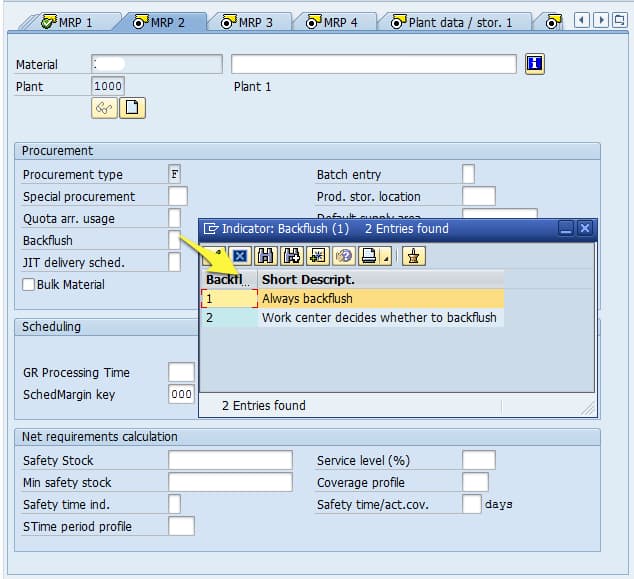
Setting two delegates the back flush to the work center.
Here is the setup of backflush in the work center.
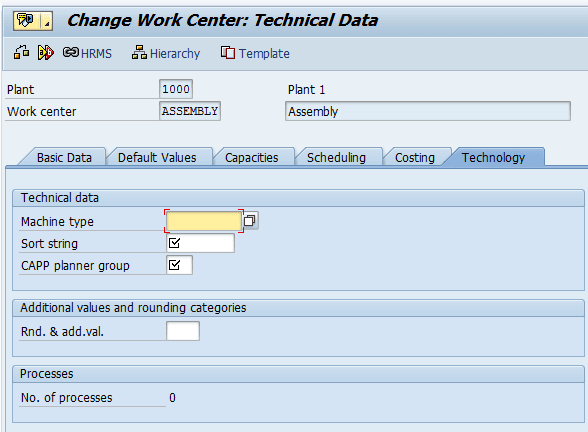
Repetitive manufacturing in SAP ERP has something called separated backflush, a separate transaction, as can be seen from the Easy Access Menu.
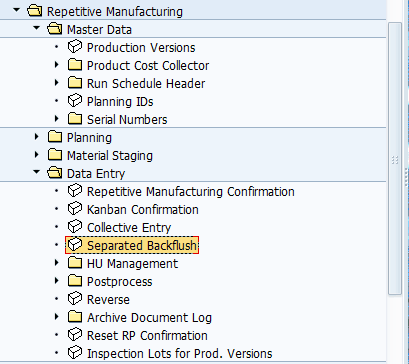
Which takes you to this screen.
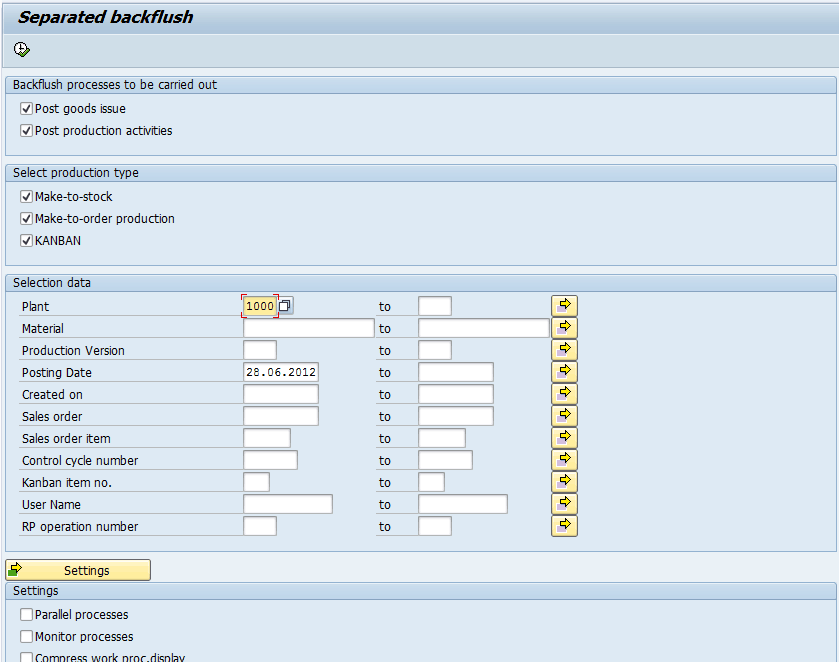
Considering the Effect of Backflushing on Accounting
The need for issuing postprocessing receipts is also reflected in backflush accounting, which, like with issuing, the costing is delayed until the production is complete.
Conclusion
Backflushing is a strangely named function for what is essentially postprocessing issues of the material. I have given it some thought, and I cannot figure out how the person that named it this thought this would be a good name.
- Backflushing can be set in three different SAP ERP areas.
- Backflushing is in ERP and not APO because it is an execution task, not a planning function.
- Backflushing is something that is frequently required in repetitive manufacturing.
- However, repetitive manufacturing on backflushing does not present more functionality in SAP ERP. Instead, backflushing is performed differently in a repetitive setup in SAP ERP when ERP is set up for discrete manufacturing.